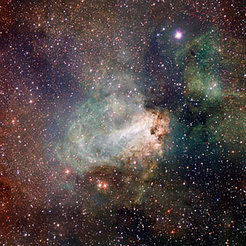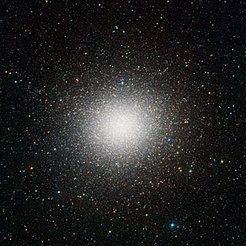First Images from the VLT Survey Telescope
VST and 268 megapixel OmegaCAM start work

Copyright: ESO/INAF-VST/OmegaCAM
A) VST image of the star-forming region Messier 17:
This image from the VLT Survey Telescope (VST) shows the spectacular star-forming region Messier 17, also known as the Omega Nebula or the Swan Nebula. This vast region of gas, dust and hot young stars lies in the heart of the Milky Way in the constellation of Sagittarius (The Archer). The VST field of view is so large that the entire nebula, including its fainter outer parts, is captured - and retains its superb sharpness across the entire image.
Credit: ESO/INAF-VST/OmegaCAM
Copyright: ESO/INAF-VST/OmegaCAM
The VLT Survey Telescope (VST) is the latest telescope to be added to ESO's Paranal Observatory in the Atacama Desert of northern Chile. It is housed in an enclosure immediately adjacent to the four VLT Unit Telescopes on the summit of Cerro Paranal under the pristine skies of one of the best observing sites on Earth. The VST is a wide-field survey telescope with a field of view twice as broad as the full Moon. Over the next few years the VST and its camera OmegaCAM will make several very detailed surveys of the southern sky. All survey data will be made public.
"I am very pleased to see the impressive first images from the VST and OmegaCAM. The unique combination of the VST and the VISTA infrared survey telescope will allow many interesting objects to be identified for more detailed follow-up observations with the powerful telescopes of the VLT," says Tim de Zeeuw, the ESO Director General.

Copyright: ESO/INAF-VST/OmegaCAM
B) VST image of the giant globular cluster Omega Centauri:
This portrait from the VLT Survey Telescope (VST) shows the globular star cluster Omega Centauri in the constellation of Centaurus (The Centaur). This is the largest globular cluster in the sky, but the very wide field of view of VST and its powerful camera OmegaCAM can encompass even the faint outer regions of this spectacular object. This view includes about 300 000 stars.
Copyright: ESO/INAF-VST/OmegaCAM
The VST is a state-of-the-art 2.6-metre aperture telescope with an active optics system to keep the mirrors perfectly positioned at all times. At its core, behind large lenses that ensure the best possible image quality, lies the 770 kg OmegaCAM camera, built around 32 CCD detectors, sealed in vacuum, that together create 268-megapixel images. OmegaCAM was designed and built by a consortium including the University Observatory Munich and the Max Planck Institute for Extraterrestrial Physics as well as other institutes in the Netherlands, Germany and Italy, and with major contributions from ESO. The University Observatory was responsible for the electronic control unit, the integration of OmegaCAM and the project management. The MPE provided major optical components. The new facility will be operated by ESO, which will also archive and distribute data from the telescope.
The VST will make three public surveys over the next five years, KIDS, ATLAS and VPHAS+. Scientists from Munich and Garching are involved in the KIDS survey, which aims to image 1500 square degrees in 4 bands. This will enable the astronomers to study dark matter halos and dark energy with weak lensing, to further investigate galaxy evolution and search for galaxy clusters as well as high redshift quasars. The KIDS project fills an important niche in lensing surveys between smaller, slightly deeper surveys, such as the CFHT Legacy Survey, and larger, shallower surveys like the SDSS.
| Notes : | ||
| [1] The VST has been designed at the Astronomical Observatory of INAF at Capodimonte, Naples. All components apart from the main optics, which were supplied by the Russian firm LZOS, have been built by Italian industries. [2] The OmegaCAM consortium is comprised of institutes in the Netherlands (NOVA, in particular the Kapteyn Institute / OmegaCEN Groningen and Leiden Observatory), Germany (in particular the university observatories of Munich, Göttingen and Bonn) and Italy (INAF, in particular the Padua and Naples observatories). The ESO Optical Detector Team provides the detector system. OmegaCAM is headed by PI K. Kuijken (Groningen and Leiden University) and co-PI's R. Bender (Munich USM/MPE) and E. Cappellaro (INAF, Osservatorio Astronomico di Padova), project management is done by B. Muschielok and R. Häfner (University Observatory of the Ludwig-Maximilians University Munich) and the data handling system is developed by OmegaCEN led by E.A. Valentijn (Groningen). |
||

![[""] B) VST image of the giant globular cluster Omega Centauri: This portrait from the VLT Survey Telescope (VST) shows the globular star cluster Omega Centauri in the constellation of Centaurus (The Centaur). This is the largest globular cluster in the sky, but the very wide field of view of VST and its powerful camera OmegaCAM can encompass even the faint outer regions of this spectacular object. This view includes about 300 000 stars.](/13122/original-1310463454.jpg?t=eyJ3aWR0aCI6MzQxLCJmaWxlX2V4dGVuc2lvbiI6ImpwZyIsIm9ial9pZCI6MTMxMjJ9--f4b290b044cb241e09701811c2be057756748eff)











